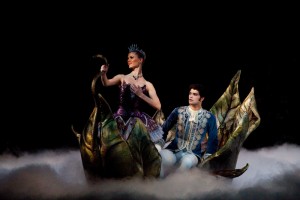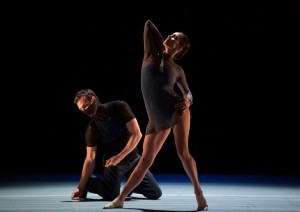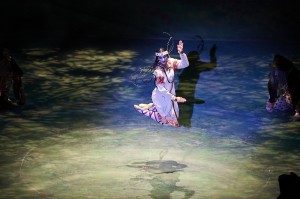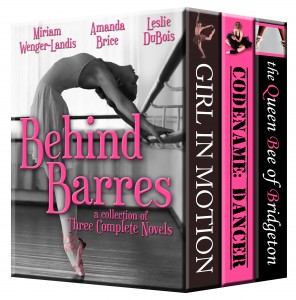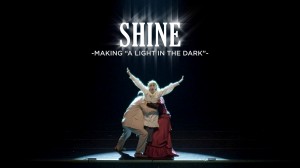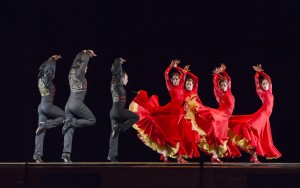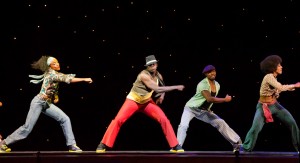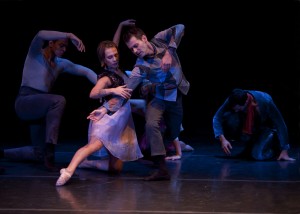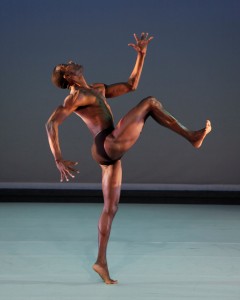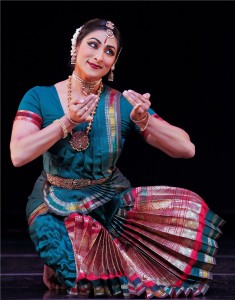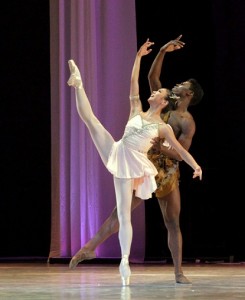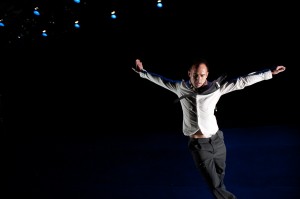You may have heard of Ballet West. Their artistic director Adam Sklute danced and was on the artistic staff of the Joffrey Ballet. In fact, you likely saw him dance “Herr Drosselmeyer” in The Nutcracker with flair and finesse a time or two. You may have seen them perform at the Chicago Dancing Festival once or twice, but aside from the fest, they haven’t toured in Chicago for over 20 years. Oh, the company also stars on the CW series Breaking Pointe, a reality show that follows the inner workings and lives of professional ballet dancers. If you’ve seen it, you’re obsessed. If you haven’t, you should. Aside from the glitz and glam of t.v. stardom, Ballet West begins their 50th anniversary season – a big deal – on tour. First stop: Chicago.
This weekend at the Auditorium Theatre, Ballet West brings two shows to town and they couldn’t be more different. Friday and Saturday, Oct. 4-5 they perform Sklute’s “reconceived” Sleeping Beauty and on Sunday, Oct. 6, they perform a repertory program that includes Val Caniparoli’s The Lottery based on the short story by Shirley Jackson. “Both programs show off the versatility of my dancers and the diversity of our repertoire,” Sklute said. “I hope that Chicago enjoys it. It’s an important engagement for us. We’re very honored and proud to come.”
Sklute, who recently married his partner of 20 years (yay!), spoke candidly over the phone about the tour, the anniversary, coming back to Chicago and, of course, Breaking Pointe. (Disclosure: Adam and I have known each other since we both worked on staff at Joffrey “x” number of years ago.)
What does it mean to you to come back to Chicago with your own company and perform on your former home stage at the Auditorium?
This is a very, very personal experience for me. For so many years I was at the Joffrey and the Auditorium was my home theater. To be going to Chicago and performing with my company for so many people that I’ve known and loved for so many years is an intense experience. I started thinking at Dance For Life…Oh my God, we’re going to be here. Ballet West is going to be here. I won’t deny that’s it’s a little overwhelming. The feelings are so big. I’m really proud of Ballet West right now. I’m really excited for my company to be seen now, because we’re very different from the great Chicago companies and a lot of the companies that have toured to Chicago, so we’re ready to bring something unique, which is exciting for me.
I can’t remember the last time anybody did Sleeping Beauty here.
That was totally a request of Brett Batterson [Executive Director of the Auditorium Theatre]. When we first started talking, he thought that was perfect. I won’t deny that ‘Sleeping Beauty’ is a little nervewracking for me. Almost more than the rep show, ‘Sleeping Beauty’ is the one that’s freaking me out. There’s such a standard to it. It requires absolute classical purity. While I’m proud of our dancers, there’s the weight of history on our shoulders. Chicago saw Margot Fonteyn dance the role of Aurora, for gosh sakes. This is my production of ‘Sleeping Beauty’. I’ve reconceived it and restaged it with the choreography of the late Mark Goldweber. In a way, it’s also my tribute to Mark, because Mark was such a part of our team that worked under Jerry Arpino when Joffrey was redefining itself in Chicago, so I love that I can bring something that shows Mark’s work. He did a lot with the children in this production and I love that we’re using so many local children to show off the ensemble. All in all, it’s pretty intense and wonderful.
What did you change in Sleeping Beauty?
I edited it down. We’re in a different era now, a different age and people have different attention spans. I tried to honor the story, honor the choreography of Petipa, the concept and Tchaikovsky’s music, but make it more palatable for a 21st century audience. I did a lot to bring out the drama in different ways, to make it an allegory. It’s not something unique, but the way I did it, I think, is unique. The fairies are now the fairy of joy, happiness, beauty, temperament and kindness, wisdom and ‘Carabosse’, the evil fairy, becomes the fairy of jealousy. The princes, the suitors in the Rose Adage are the Princes of the North, South, East and West. The Prince that’s known as ‘Florimund’ is now ‘Prince Desire’. She’s awakened by the kiss of desire at the age of 16, or 116 as the case may be. We tightened up the action. Things to sort of make it move along.
Tell me about the rep show.
I’m really excited about. I think that the company looks smashing. We have the world premiere of ‘Pas de Quatre’ by my resident choreographer Nicolo Fonte and the pas from ‘Diamonds’. ‘The Lottery’, based on Shirley Jackson’s short story. It’s a really intense story. The person that gets killed dances a really long, complicated solo and it’s a cast of 14, so everyone in the cast has to be ready to go for any given night. They don’t know if they will have to dance the long, hard solo at the end of the night or not. It’s pretty incredible. When people are picking their “ticket”, the audience can see it. The tension is palable. It’s not just dramatic tension. They are literally wondering if they have to do it. It adds to the drama of the moment. It’s not predetermined. It happens right there on stage. The way Val has done it is so expert. Val always told us the story is kind of like “The Rite of Spring” meets “Leave it to Beaver”. In a way, it’s also our own homage to the 100th anniversary of “Rite”. [Sklute was part of Joffrey’s 1987 reconstruction of Le Sacre du Printemps/The Rite of Spring.]
Let’s talk Breaking Pointe. I think it’s brilliant that you said yes to it. I’m sure people are wondering what you’re doing, but I think it brought your profile up and made fans around the world. Do you still think it was a good idea? How hard is it to cameras everywhere all the time?
Thank you for saying that. We took a big chance. I wasn’t going to do it if the dancers said no. We all agreed to do it as a group, not only for Ballet West, but what we thought was for ballet. We’re not doing this show for the thousands of people that know and love ballet. We’re doing this show for the millions of people that know nothing about ballet. Is it necessarily about the art? No, but it is about dancers and dancers’ lives. I’ve heard so many things from positive to negative, but what I love is that we’re giving a face to what dancers’ lives are like and what they go through to people that would never know. I’m really pleased that we did it. Was it hard? It was so freakin’ hard. I can’t tell you how awful it was to have cameras in our faces practically 24/7. Dancers would have cameras coming to their houses after rehearsals. It was so hard, but we think still that it was worth it. Was everything exactly as we wanted it? No. I would’ve loved more dance. It is what it is. For all those people saying “why isn’t there more dance?” “Why are you using cheesy music over it”? People don’t realize that reality shows are done on a shoestring budget. The Prokofiev Estate, for ‘Cinderella’, is one of the most expensive to get. A lot of times the producers couldn’t afford to buy that much music. Plus on top of that, to use the actual choreography for clips more than a certain amount of seconds, they had to negotiate and pay for the Ashton choreography to be seen. I can deal with whatever the fallout is as long as the dancers look good in rehearsals and class and performances, I was fine. Even if the clips are short or of personal lives or partying or one too many body shots…whatever it is, Seriously! Really people, you had to do that on camera?
You forget that some of them are just 21-years-old.
Right? Vicki, I maintain we were worse when we were that age. We didn’t talk about it. We didn’t know what planet we were on, but by morning we were in class. If these people say you can go into their personal lives, then you can go there. I try to stay out of my dancer’s personal lives. Can I just tell ya, the real drama that was going on in our company during that time…well, the drama on t.v. pales in comparison to what was really happening. What you see on t.v. is 100% real, but there were things going on that were way more scandalous.
Will there be a Season 3?
I have no idea. I’m not 100% sure I want to do a Season 3. This was so exhausting and intense, but on the other hand, if they came to us, we probably would.
Have you noticed an uptick in ticket sales since the show?
We have. The biggest thing has been what we call the “institutional marketing” part of the company. Ticket sales have seen a bump, but really it’s not about that as much as it’s about our name recognition and about the face we’re giving to ballet in general. Certainly on t.v. the Nielson ratings haven’t been very good for the show. Season 1 wasn’t either. But we’re finding out that we’re the CW Channel’s top trending social media show and the top show for online rerun viewing. That matters for something. Every single night our episodes run, we’re in the top ten tv shows during that time period. Obviously something is right.
I have to mention your scarves. Everyone on Twitter is obsessed with you wearing scarves. They’ve even suggested you create your own line.
That’s hilarious. Everyone is saying “you’re totally doing the Mr. Arpino thing”. I had a terrible cold during the entire filming process. The entire ten weeks they were with us I couldn’t shake this cold. I was always cold. I always had the sniffles. I was always wearing one scarf after another. I found out later that was trending.
Ballet West performs at the Auditorium Theatre, 50 E. Congress Pkwy., Friday-Sunday, Oct. 4-6. Performance times vary. Tickets are $30-$90; call 800.982.2787 or visit the Auditorium Box Office or buy online at auditoriumtheatre.org.

